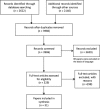The challenges of uncertainty and interprofessional collaboration in palliative care for non-cancer patients in the community: a systematic review of views from patients, carers and health-care professionals
- PMID: 24821710
- PMCID: PMC4232314
- DOI: 10.1177/0269216314531999
The challenges of uncertainty and interprofessional collaboration in palliative care for non-cancer patients in the community: a systematic review of views from patients, carers and health-care professionals
Abstract
Background: Primary care has the potential to play significant roles in providing effective palliative care for non-cancer patients.
Aim: To identify, critically appraise and synthesise the existing evidence on views on the provision of palliative care for non-cancer patients by primary care providers and reveal any gaps in the evidence.
Design: Standard systematic review and narrative synthesis.
Data sources: MEDLINE, Embase, CINAHL, PsycINFO, Applied Social Science Abstract and the Cochrane library were searched in 2012. Reference searching, hand searching, expert consultations and grey literature searches complemented these. Papers with the views of patients/carers or professionals on primary palliative care provision to non-cancer patients in the community were included. The amended Hawker's criteria were used for quality assessment of included studies.
Results: A total of 30 studies were included and represent the views of 719 patients, 605 carers and over 400 professionals. In all, 27 studies are from the United Kingdom. Patients and carers expect primary care physicians to provide compassionate care, have appropriate knowledge and play central roles in providing care. The roles of professionals are unclear to patients, carers and professionals themselves. Uncertainty of illness trajectory and lack of collaboration between health-care professionals were identified as barriers to effective care.
Conclusions: Effective interprofessional work to deal with uncertainty and maintain coordinated care is needed for better palliative care provision to non-cancer patients in the community. Research into and development of a best model for effective interdisciplinary work are needed.
Keywords: Palliative care; chronic obstructive pulmonary disease; community health services; heart failure; interprofessional relations; primary health care.
© The Author(s) 2014.
Conflict of interest statement
Figures
Comment in
-
Non-cancer palliative care in the community needs greater interprofessional collaboration to maintain coordinated care and manage uncertainty.Evid Based Nurs. 2015 Jul;18(3):79. doi: 10.1136/eb-2014-102029. Epub 2015 Feb 19. Evid Based Nurs. 2015. PMID: 25700028 No abstract available.
Similar articles
-
Interventions for interpersonal communication about end of life care between health practitioners and affected people.Cochrane Database Syst Rev. 2022 Jul 8;7(7):CD013116. doi: 10.1002/14651858.CD013116.pub2. Cochrane Database Syst Rev. 2022. PMID: 35802350 Free PMC article.
-
The experiences of midwives and nurses collaborating to provide birthing care: a systematic review.JBI Database System Rev Implement Rep. 2015 Nov;13(11):74-127. doi: 10.11124/jbisrir-2015-2444. JBI Database System Rev Implement Rep. 2015. PMID: 26657466
-
Early palliative interventions for improving outcomes in people with a primary malignant brain tumour and their carers.Cochrane Database Syst Rev. 2022 Jan 6;1(1):CD013440. doi: 10.1002/14651858.CD013440.pub2. Cochrane Database Syst Rev. 2022. PMID: 34988973 Free PMC article.
-
Factors that influence participation in physical activity for people with bipolar disorder: a synthesis of qualitative evidence.Cochrane Database Syst Rev. 2024 Jun 4;6(6):CD013557. doi: 10.1002/14651858.CD013557.pub2. Cochrane Database Syst Rev. 2024. PMID: 38837220 Free PMC article. Review.
-
Factors that impact on the use of mechanical ventilation weaning protocols in critically ill adults and children: a qualitative evidence-synthesis.Cochrane Database Syst Rev. 2016 Oct 4;10(10):CD011812. doi: 10.1002/14651858.CD011812.pub2. Cochrane Database Syst Rev. 2016. PMID: 27699783 Free PMC article.
Cited by
-
Barriers and Facilitators to Effective Inpatient Palliative Care Consultations: A Qualitative Analysis of Interviews With Palliative Care and Nonpalliative Care Providers.Am J Hosp Palliat Care. 2019 Mar;36(3):191-199. doi: 10.1177/1049909118793635. Epub 2018 Aug 14. Am J Hosp Palliat Care. 2019. PMID: 30103619 Free PMC article.
-
Nurses' Perceptions Regarding End-of-life Care for Individuals with Non-cancer Diseases on Non-invasive Positive Pressure Ventilation-dependent: A Qualitative and Descriptive Study.Indian J Palliat Care. 2023 Apr-Jun;29(2):175-180. doi: 10.25259/IJPC_184_2022. Epub 2023 Jan 11. Indian J Palliat Care. 2023. PMID: 37325269 Free PMC article.
-
Identifying potentially inappropriate prescribing in older people with dementia: a systematic review.Eur J Clin Pharmacol. 2019 Apr;75(4):467-481. doi: 10.1007/s00228-018-02612-x. Epub 2019 Jan 4. Eur J Clin Pharmacol. 2019. PMID: 30610274
-
Towards integration of palliative care in patients with chronic heart failure and chronic obstructive pulmonary disease: a systematic literature review of European guidelines and pathways.BMC Palliat Care. 2016 Feb 13;15:18. doi: 10.1186/s12904-016-0089-4. BMC Palliat Care. 2016. PMID: 26872741 Free PMC article.
-
A Study Protocol of Realist Evaluation of Palliative Home Care Program for Non-Cancer Patients in Singapore.Int J Integr Care. 2022 Oct 20;22(4):7. doi: 10.5334/ijic.6497. eCollection 2022 Oct-Dec. Int J Integr Care. 2022. PMID: 36348942 Free PMC article.
References
-
- National Hospice and Palliative Care Organization. NHPCO facts and figures: hospice care in America, 2012 edition, 2012, http://www.nhpco.org/sites/default/files/public/Statistics_Research/2012...
-
- The National Council for Palliative Care. National survey of patient activity data for specialist palliative care services: MDS full report for the year 2011–2012, 2012, http://www.ncpc.org.uk/sites/default/files/MDS%20Full%20Report%202012.pdf
-
- Fukui S, Yoshiuchi K, Fujita J, et al. Japanese people’s preference for place of end-of-life care and death: a population-based nationwide survey. J Pain Symptom Manage 2011; 42(6): 882–892. - PubMed
-
- Murtagh FEM, Bausewein C, Sleeman K, et al. Understanding place of death for patients with non malignant conditions: a systematic literature review. Southampton: National Institute of Health Research, 2012.
-
- Field D. Special not different: general practitioners’ accounts of their care of dying people. Soc Sci Med 1998; 46(9): 1111–1120. - PubMed
Publication types
MeSH terms
LinkOut - more resources
Full Text Sources
Other Literature Sources
Medical



